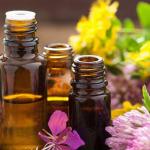One of my favorite groups of essential oils and botanical fragrances is a group we could call the sacred scents...
What makes a particular fragrance sacred versus not sacred?
When we study essential oils and we learn about their origin, cosmology, energies and elements, we learn that all plants are under the influence of the sun and the moon and they all contain very ancient genetic intelligence that is immunological and evolutionary in nature.
If we’re looking at essential oils through this larger cosmology, we see that they are actually the end result of a universal creative process. We think of them just as chemicals produced by plants, but actually they’re produced by nature, by the intelligence of the biosphere and the cosmos.
In this sense, all herbal medicine is sacred (as well as food).
Aromatics & Our Spiritual Human History
If we look through human history, we see that there are definitely some plants that people have always gravitated towards for spiritual aspirations and use in ceremony and ritual.
This group of fragrances has a unique relationship to our human spiritual history and are probably some of the most important aromatic substances that have been used in spiritual traditions around the world.
These also include, agarwood and sandalwood from Asia, from the Middle East, frankincense, from South America, Palo Santo and in North America, cedar and white sage. A few more include copal in Central America, myrrh in the Middle East and flowers such as rose, lotuses and cistus.
These are the main plants that are always found over and over again being used in temples, shrines, mosques, churches, pagodas and caves - anywhere where rituals are taking place.
Why are most of these sacred fragrances “sweet”?
Sweet plants are very pleasing and pleasant to be around. The sweet fragrance has unique effects on human consciousness that is different than the stimulant spicy oils and other kinds of aromas.
In herbal medicine, herbs that are sweet in taste are classified as nourishing to the body. The sweet fragrances are also nourishing, but they don’t nourish us physically — they nourish us spiritually. They’re used in ceremony and ritual to nourish the spirit by placing them on a coal or burning as incense or making a perfume and then anointing with them.
Medical Benefits of Aromatics
These aromatics are calming to anxiety and uplifting to the mood simultaneously, so they are antidepressant and antianxiety. If we study human spiritual activity throughout history in different cultures, we see that what takes people to church, temples mosques and other spiritual centers frequently is related to depression and anxiety.
People go to sacred places, to temples, to find some spiritual guidance or some spiritual nourishment or to help relieve their anxiety to find some inner peace during periods of uncertainty.
Because these plants have such a positive effect on our mental state and moods, they can also be said to purify us spiritually because really, if we’re suffering from depression or anxiety, the mind is needing spiritual healing.
When the mind and the emotions return back to a state of balance, inner peace and happiness, we could say that we’re back on the spiritual path and have returned to a spiritual state.
They’re also strongly antimicrobial, so when we burn them, they purify the atmosphere and protect against contagions. They provide protection against disease and in the past, people didn't have a concept of microbial life, but they could smell pathogens in the environment and they knew that bad smells brought diseases, so they used these plants to ward off “curses” or “evil spirits.”
Sacred Plants for Meditation
All of these plants help us to become more peaceful internally and therefore, are very easy to bring into our daily life. It’s very easy to put one small tear of frankincense on a coal or incense burner to help focus the mind. When the fragrance comes out into the room, it has a pacifying effect that helps us to separate from usual external activities in the world. They can also be made into various oil preparations and used for anointing.
Adding a little fragrance to meditation has a very powerful positive and supportive effect on any type of meditation and becomes a way of helping our mind to become focused, clear, balanced and peaceful. We can also draw inspiration, stimulate creativity, or simply enhance meditation with these plants.
If we look at all the different types of spiritual practices, we see that we can engage all five senses. We might engage sight by focusing on a sacred image. During a retreat, we might avoid certain foods to support the process, so we engage our taste. Sound is also important in sacred music or chanting or mantra.
However, the sense of smell is one of the most powerful senses to support meditation. When we inhale the fragrances, they go directly to the limbic system which controls our mental state and emotional wellbeing. Using these plants as fragrance actually gives us a direct link to the mind and we can work with that link very consciously not just by choosing specific fragrances, but by choosing specific types of meditations that we would like to use with those fragrances as well.
Meditation Practice
Before I share specific details about each of these fragrances and how to use them, I want to share a personal method I use for meditation:
I take a little bit of the oil of one of these sacred plants, any of these five, and just put one drop on the tip of my index finger. Then I sit quietly in meditation and rub my index finger and thumb together. I breathe in slowly and breathe in the fragrance with a specific intention. This intention can be to calm the mind, to focus on a goal or resolving an internal problem.
By engaging your sense of smell, you support your body’s natural ability to relax, to manifest and to heal.
5 Sacred Aromatic Plants for Meditation & Healing
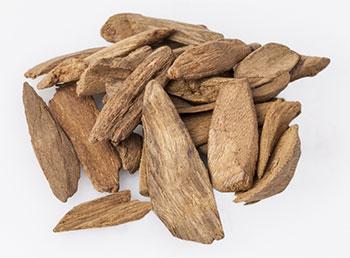 Agarwood is a very nice fragrance to use in meditation and is used extensively in Buddhist and Taoist temples across China, Japan and Southeast Asia because it helps to support a meditative, contemplative mood. It also works at a deep spiritual level to bring you what you need.
Agarwood is a very nice fragrance to use in meditation and is used extensively in Buddhist and Taoist temples across China, Japan and Southeast Asia because it helps to support a meditative, contemplative mood. It also works at a deep spiritual level to bring you what you need.
Agarwood is a very expensive oil. You might prefer to get a small piece of the agarwood itself. The way that it’s used most efficiently and cost effectively, is to put a very small piece of the wood in a special electric heater. Incense burners generally use coal and work well, however, an electric heater is actually better because it vaporizes the fragrance without creating much smoke.
We put a small piece of agarwood in the heater and just turn it on and start our meditation. Slowly, this beautiful fragrance comes and we begin to feel a change within our inner sense of wellbeing. People actually start to feel euphoria, calm and tranquility with agarwood. There's a consistent and repeatable feeling of joy that comes from smelling the fragrance of agarwood.
If you get the oil, you’ll notice it’s highly concentrated and very strong smelling. You can anoint yourself with one drop on your forehead, neck or the pulse point of your wrist. You’ll notice that it also has a very strong benefit on consciousness.
The agarwood will give you blessings in some very surprising ways. These blessings happen synchronistically and are based on helping to support the manifestation of your life purpose.
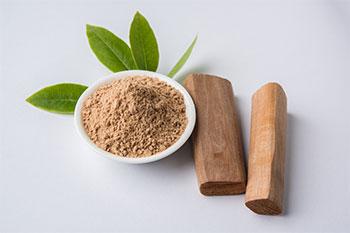 Sandalwood is an excellent oil for reducing stress. It has an immediate and significant calming effect on an overstimulated sympathetic nervous system when the adrenal glands are in fight or flight from stress.
Sandalwood is an excellent oil for reducing stress. It has an immediate and significant calming effect on an overstimulated sympathetic nervous system when the adrenal glands are in fight or flight from stress.
Sandalwood oil for anointing or sandalwood in the burner has always been considered a very spiritual scent because the spiritual state of mind is free of stress. If we are free of stress, then we’re closer to our spiritual nature.
Of course, just smelling sandalwood or any fragrance by itself, is not going to create magical transformations. We have to do our spiritual homework — meditating, sitting quietly, relaxing — but the plants can help us to calm our mind and return to our spiritual nature.
Like agarwood oil, sandalwood oil is very rare and expensive. It’s so precious that you don’t want to put it in a diffuser. It’s best in an incense heater or you can use one drop for anointing yourself. Both oils are very safe to apply directly on the skin and don’t need carrier oils, however you can dilute them in a carrier oil to help make them last longer.
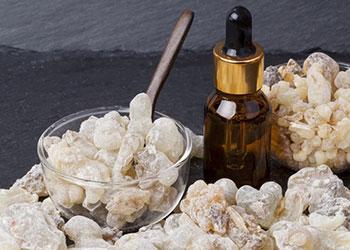 Frankincense has significant mood uplifting antidepressant effects and significant anxiolytic calming, relaxing effects. Frankincense has a very nice uplifting effect in the home as well.
Frankincense has significant mood uplifting antidepressant effects and significant anxiolytic calming, relaxing effects. Frankincense has a very nice uplifting effect in the home as well.
Frankincense also has a very significant antimicrobial, atmospheric purification effect.
It’s especially helpful during the cold and flu season because it’s excellent for preventing airborne contagions and pathogens as well as treating respiratory conditions.
There are two primary ways to use frankincense — in a diffuser and applied directly to the body for anointing. There’s no exact recipe for the number of drops that you need in a diffuser. The more you put in, the stronger it will be, but there’s no “right amount” and each diffuser varies. I recommend to just put some oils in and turn it on.
To anoint yourself with the frankincense oil, you should dilute it and not put it undiluted on your skin. A very simple recipe is one ounce of a carrier oil (coconut, sesame or jojoba) with 5 to 10 drops of frankincense essential oil. This will make a very nice blend for you to anoint yourself on your forehead, heart chakra point, neck or pulse points or to use on your index finger for meditation.
There’s a third way to use frankincense, which is to burn the resin. You can burn the resin by placing a small piece on a coal which will produce smoke, or an an incense heater where it won’t burn, it will just melt it slowly and release its fragrance.
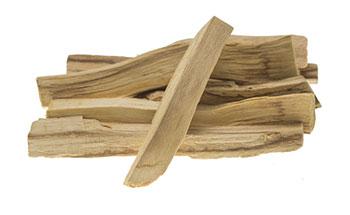
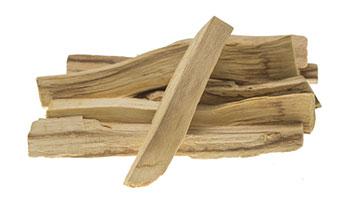 Palo Santo smoke is very psychoactive, it has very, very significant benefits for anxiety and depression. It’s also very uplifting and euphoric. The belief in Central and South America is that this tree wants to take care of you. It wants to protect you, bring you good things, remove negativity from your mind, your life and your home, and it wants to attract blessings. If we use it with this in mind, then we’re actually joining together our intention with the intention of the tree.
Palo Santo smoke is very psychoactive, it has very, very significant benefits for anxiety and depression. It’s also very uplifting and euphoric. The belief in Central and South America is that this tree wants to take care of you. It wants to protect you, bring you good things, remove negativity from your mind, your life and your home, and it wants to attract blessings. If we use it with this in mind, then we’re actually joining together our intention with the intention of the tree.
Palo Santo smoke is used ceremonially in South America, almost like fumigation to clear out illness and impurities. Palo Santo is often found in sticks which are rich in resin and oil. To burn the wood, light the stick (it will light like a torch, so use caution) and once the stick is lit, shake it out so that it’s not burning and can be used as a smudge stick.
Palo Santo can also be used with a few drops in a diffuser or in the palm of your hand. For direct palm inhalation, put 1-2 drops on the palm of one hand and rub the hands together. Then hold your palms close to your face as you are starting your meditation practice and just inhale the fragrance a few times.
Just one or two drops before starting meditation once or twice a day will give you a very, very nice relaxant kind of effect. (Caution: an excessive amount of oil can irritate your sinuses, so use just in your meditation practice once or twice daily.)
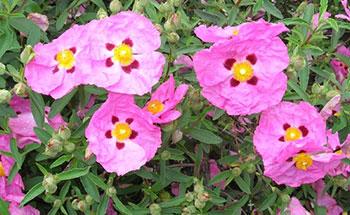 Cistus is an essential oil and it’s very concentrated and very strong. It has a very long history in the tradition of temple incenses, but is not well known outside of perfumery.
Cistus is an essential oil and it’s very concentrated and very strong. It has a very long history in the tradition of temple incenses, but is not well known outside of perfumery.
Historically, cistus was also called labdanum. This comes from a sticky resonance leaf of a bush that grows in the Mediterranean. This resin labdanum and the essential oil that is now distilled from it, have been used in preparations for temple incense around the Mediterranean region for a millennia.
It has a very sweet floral herbaceous fragrance that produces a wonderful, euphoric feeling and is very supportive of meditation. It’s also good for the skin and treating skin conditions and has a cooling effect.
Although it is safe to put directly on the skin, it is a very strong fragrance and we recommend dilution with a carrier oil. You only need a drop or two because it is so concentrated. With that, you can do the same type of application to the fingertips to breathe it and then anoint yourself.
What’s your favorite meditation practice? What’s your favorite scent for clearing your mind? Do you prefer using diffusers or anointing? We’d love to hear from you!
Discover how to use 3 powerful oils for healing, sleep and alleviating anxiety and unlock the life-enhancing power of essential oils to overcome disease, cultivate more energy, and relax your body and mind in David Crow’s FREE class The Next Level of Using Essential Oils for Healing: Harness the Power of Specific Remedies From Ayurveda, Chinese Medicine & Modern Aromatherapy.






